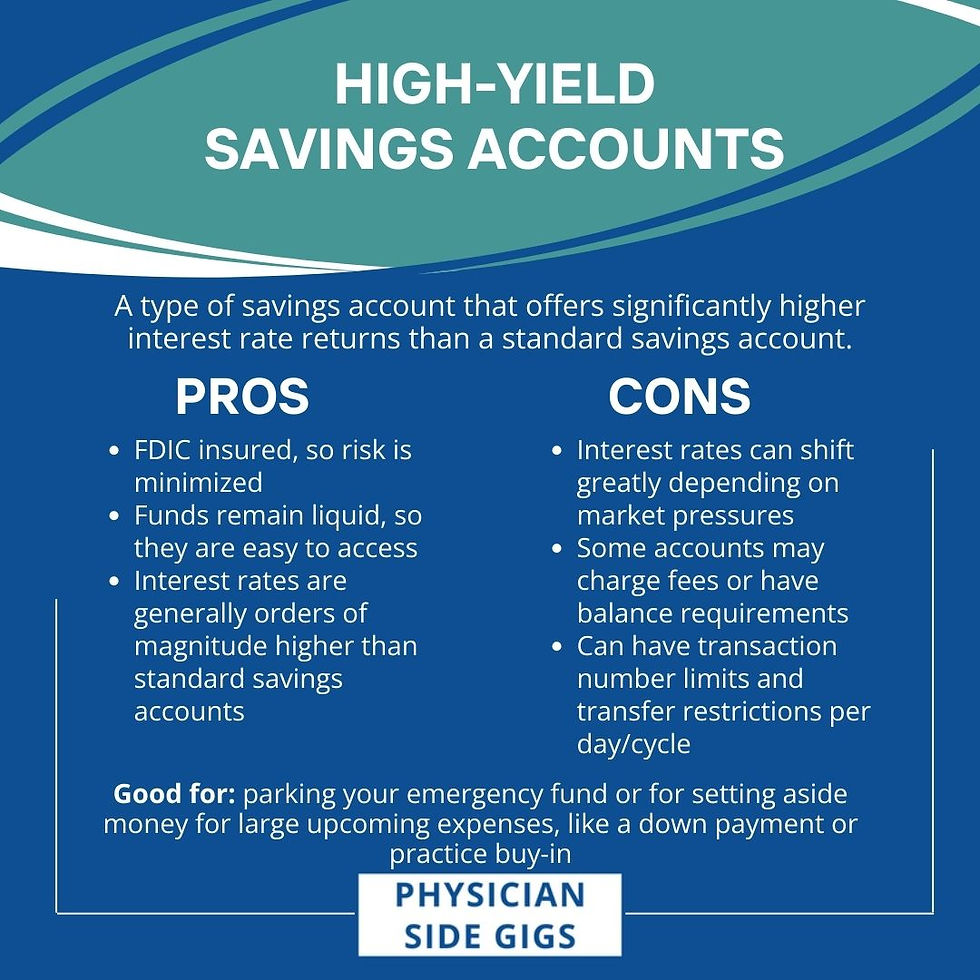Why High-Yield Savings Accounts Are Important for Young Adults
 Image source: Quick and Dirty Tips
Image source: Quick and Dirty Tips
The Benefits of Starting Early with a Savings Plan
Starting a savings plan at a young age is one of the most strategic financial choices a young adult can make. High-yield savings accounts (HYSAs) play a crucial role in this journey, offering a robust vehicle for accumulating wealth over time.
- Compound Interest: When young adults open a high-yield savings account early, they benefit from compound interest. Interest earns interest, creating exponential growth on your savings. According to a report by Bankrate, even a small amount set aside can accumulate significantly over the years due to this compounding effect.
- Financial Discipline: Establishing a savings plan fosters financial discipline. Learning to save a portion of earnings encourages smart spending habits and instills a sense of responsibility regarding finances.
- Emergency Fund Creation: Young adults are at a pivotal stage of life, often facing unexpected expenses. A high-yield savings account can help build a safety net. This fund can cover emergencies like car repairs or medical bills, eliminating the need for credit card use and potential debt accumulation.
- Goal Achievement: Whether it’s saving for a trip, education, or a major purchase, a high-yield savings account not only allows young adults to save but also provides motivation to reach financial goals faster and more efficiently.
How High-Yield Accounts Differ from Regular Savings Accounts
Understanding the distinctions between high-yield savings accounts and standard savings accounts is vital for young adults aiming to maximize their savings.
- Higher Interest Rates: The most significant difference is the interest rate. HYSAs typically offer much higher rates than traditional savings accounts. As of now, these rates can be around 3% to 4% or more, compared to the national average of around 0.05% for regular accounts. This key difference allows savers to earn more on their deposits.
-
Online Presence: Many high-yield accounts are offered by online banks, which often have lower overhead costs. Consequently, they can pass these savings onto customers in the form of higher interest rates. Regular savings accounts, typically found at traditional banks, may not provide the same competitive rates due to higher operating expenses.
-
Accessibility: While high-yield accounts provide excellent returns, they may have limited access to funds compared to regular savings accounts. Withdrawals may be restricted to a limited number per month, encouraging long-term savings.
-
Fees and Minimum Balances: High-yield savings accounts may have different parameters regarding fees and minimum balance requirements. It’s essential for young adults to review these terms to avoid unexpected costs.
In summary, by starting with a high-yield savings account, young adults can take advantage of higher interest rates, develop beneficial financial habits, and pave the way toward a secure financial future. Be sure to conduct research and compare different options to find the best account suited for your needs.
Factors to Consider When Choosing a High-Yield Savings Account
 Image source: Squarespace
Image source: Squarespace
Interest Rates: Why Rate Fluctuations Matter
When selecting a high-yield savings account (HYSA), understanding interest rates is crucial. The rates can vary significantly from one financial institution to another and can fluctuate based on economic conditions. Typically, high-yield accounts offer a better interest rate compared to traditional savings accounts, allowing your money to grow faster over time.
It’s essential to look for annual percentage yields (APY), which indicate the rate of return on your savings. Even a small difference in APY can make a substantial impact on your savings over time, particularly as you maintain higher balances. For example, if one account offers a 0.50% APY while another provides 2.00%, the difference in earnings can be considerable after several years.
Additionally, keep an eye on how frequently the interest is compounded—daily compounding will yield more interest than monthly compounding. To stay informed about current rates, consider checking reliable financial websites like Bankrate that provide updated comparisons.
Account Fees and Minimum Balance Requirements
Fees and minimum balance requirements are critical factors that can affect the overall profitability of a high-yield savings account. Many accounts advertise attractive APYs but may include hidden fees that can diminish your interest earnings. Common fees to watch out for include maintenance fees, withdrawal fees, and penalties for falling below a minimum balance.
Before committing to an account, scrutinize the bank’s fee schedule. Some financial institutions waive fees if you maintain a certain balance, while others may impose fees regardless of your balance. Therefore, always check if the account aligns with your saving habits—if your savings fluctuate, an account with no monthly fees and a lower minimum balance requirement might be the best option.
Make sure to read the fine print and calculate how fees could affect your savings over time. Selecting a high-yield savings account with no fees and reasonable balance requirements maximizes your ability to earn interest and grow your savings.
Accessibility: Online vs. Traditional Banks
Accessibility is another significant aspect to consider when choosing a high-yield savings account. With the rise of online banks, many offer higher interest rates due to lower operating costs compared to traditional brick-and-mortar banks. Online accounts often come with fewer fees and more attractive APYs, making them a popular choice for many.
However, while online banks provide convenient access via mobile apps and websites, some individuals may prefer traditional banks for their in-person services. If having face-to-face communication or easy access to cash withdrawals is paramount for you, a traditional bank can be a better fit.
Evaluate how frequently you access your savings, whether for emergency use or planned expenses, as this will influence your choice. Many online banks also provide excellent customer service, but it may be primarily through chat or email rather than in-person. When making your decision, consider what type of access and support will best suit your saving habits.
In summary, choosing the right high-yield savings account involves more than just looking at the interest rate. By assessing interest rates, account fees, and accessibility options, you can find an account that not only amplifies your savings but also aligns seamlessly with your financial lifestyle.
Top High-Yield Savings Accounts for Young Adults in 2025
 Image source: InternationalBaatE
Image source: InternationalBaatE
Account 1: Ally Bank – Features and Benefits
Ally Bank continues to be a favored choice among young adults seeking robust high-yield savings accounts. With an impressive APY (Annual Percentage Yield) of 4.00% as of 2025, it outshines many traditional banks. The account boasts no monthly maintenance fees and no minimum balance requirements, making it accessible for those just starting their financial journey.
Features and Benefits:
- No Fees: Enjoy a cost-free experience with no hidden monthly maintenance fees.
- Online Accessibility: Ally Bank is entirely online, providing seamless access to your funds through an intuitive mobile app.
- 24/7 Customer Support: Get help whenever you need it through chat, email, or phone support.
For more in-depth insights, check out this Ally Bank Review.
Account 2: Marcus by Goldman Sachs – Features and Benefits
Marcus by Goldman Sachs offers a high-yield savings account with a competitive APY of 3.75%. Tailored for young adults, this account requires no minimum deposit and has zero monthly fees, allowing users to save without any financial burden.
Features and Benefits:
- High APY: Benefit from one of the top interest rates available for savings accounts.
- User-Friendly Interface: The online dashboard and mobile app make navigating your finances easy.
- No Withdrawals Limit: Marcus allows you to manage your funds flexibly, with no restrictions on the number of transactions.
Learn more about this account by visiting Marcus by Goldman Sachs.
Account 3: Discover Bank – Features and Benefits
Discover Bank rounds out the list with its high-yield savings account offering a substantial APY of 3.50%. This account is ideal for young adults who prefer an institution with a strong reputation and extensive customer service.
Features and Benefits:
- Rewarding Rates: Keep your savings growing with a competitive interest rate.
- No Fees: Discover Bank does not impose monthly fees or minimum balance requirements.
- Strong Customer Service: Customers can access 24/7 support, ensuring help is always available when needed.
To explore the benefits further, visit Discover Bank.
For young adults looking to maximize their savings potential, these high-yield savings accounts provide a practical, flexible, and rewarding choice, ultimately setting the stage for financial success.
Pros and Cons of High-Yield Savings Accounts
Advantages: Security, Growth Potential, and More
High-yield savings accounts (HYSAs) offer a host of advantages that make them an attractive choice for both young adults and seasoned savers alike. Here are some of the key benefits:
- Security: One of the most significant advantages of high-yield savings accounts is the inherent safety they provide. Most HYSAs are offered by reputable banks and financial institutions, and deposits are typically insured by the Federal Deposit Insurance Corporation (FDIC) up to $250,000 per depositor. This gives account holders peace of mind knowing their money is protected.
-
Higher Interest Rates: HYSAs often provide higher interest rates than traditional savings accounts. This means your money grows faster over time, substantially boosting your savings potential. Some institutions offer rates that are many times higher than the national average for standard savings accounts, allowing your funds to compound more effectively.
-
Liquidity: Unlike certain investment options, HYSAs allow for easy access to your funds when you need them. You can transfer money in and out of your high-yield account with relative ease, which provides both flexibility and convenience compared to fixed-term investments.
-
No Commitment: High-yield savings accounts typically do not have long-term commitments. You can deposit or withdraw money without penalties, giving you the freedom to manage your finances without the constraints of a fixed term.
For further insights on the advantages of high-yield savings accounts, visit Investopedia.
 Image source: Wix
Image source: Wix
Drawbacks: Limited Access to Money and Lower Returns Compared to Investments
While high-yield savings accounts come with numerous benefits, they also have some notable drawbacks that potential account holders should consider:
- Limited Access to Money: Although HYSAs allow for more flexible access compared to other investments, they still come with restrictions. Most accounts limit the number of withdrawals or transfers to six per statement cycle due to federal regulations. This can be inconvenient for those who may need frequent access to their funds.
-
Lower Returns Compared to Investments: While high-yield savings accounts offer better rates than traditional savings, their returns still pale compared to potential earnings from stock market investments or other higher-risk options. If your primary goal is growth, you might find that investing in stocks or mutual funds provides significantly higher returns over the long term.
-
Interest Rate Fluctuations: The interest rates on high-yield savings accounts can fluctuate based on market conditions and central bank policies. This means that the attractive rate you opened the account with may not remain the same, leading to uncertainty in future earnings.
In conclusion, while high-yield savings accounts serve as a secure and flexible saving tool with competitive interest rates, they may not suit everyone’s financial strategy, particularly for those seeking high returns through aggressive investments or consistent cash flow. Balancing your savings strategy with these pros and cons in mind is essential for achieving your financial goals.
Tips to Maximize Your High-Yield Savings Even Further
Automate Your Savings for Consistent Growth
One of the most effective strategies to maximize growth in your high-yield savings account is to automate your savings. Setting up automatic transfers from your checking account to your savings account ensures that a portion of your income is consistently saved without requiring manual intervention. This method not only promotes discipline but also instills a habit of saving that can significantly enhance your financial growth over time.
Consider scheduling transfers right after you receive your paycheck. This way, you’re prioritizing your savings before you have the chance to spend it. Even a modest amount can accumulate quickly with regular contributions, making a significant impact when combined with the higher interest rates provided by high-yield accounts. According to a study by the American Institute of CPAs, individuals are more likely to save consistently when they automate their contributions.
Moreover, heightened awareness of emergency funds and future goals encourages young adults to automate their savings further. For a more detailed understanding of automating savings, refer to NerdWallet’s automation guide.
Take Advantage of Compound Interest by Reinvesting Interest Earnings
Compound interest is one of the most powerful drivers of wealth accumulation, particularly in high-yield savings accounts. When you choose to reinvest your interest earnings instead of withdrawing them, you’re effectively leveraging the power of compounding. This strategy allows your interest to earn additional interest, creating a snowball effect that can dramatically increase your savings over time.
To visualize this effect, consider that if you have $1,000 in a high-yield savings account earning 2% interest annually, you’ll accumulate $20 by the end of the year. If you reinvest that interest, your new balance becomes $1,020, and the following year, you would earn interest on the entire amount rather than just the initial $1,000. This not only leads to more money accumulated but also ingrains a mindset of sustainable financial growth.
For instance, if you maintain your balance and let your interest reinvest over multiple years, the future value of your savings can grow exponentially. Online calculators, like those found at Bankrate, can help you understand the benefits of compounding and how reinvesting your earnings can work in your favor.
By automating your savings and reinvesting your interest, you set yourself on a path to financial independence and a more robust savings strategy. These tactics ensure that your high-yield savings account works harder for you, helping you reach your financial goals faster.
Concluding Remarks: Secure Your Financial Future with the Best High-Yield Savings Accounts
In today’s financial landscape, being proactive about savings is crucial, particularly for young adults entering the workforce. High-yield savings accounts (HYSAs) represent a solid strategy to cultivate savings while aiming for higher interest returns compared to traditional savings accounts. As explored throughout this article, these accounts offer numerous benefits, including enhanced financial security and the ability to grow your money through compound interest.
To make the most of your high-yield savings experience, consider the factors we’ve discussed: interest rates, account fees, and accessibility options. By comparing various high-yield savings accounts, you can ensure that you choose one tailored to your unique financial situation. Whether your priority is maximizing interest or minimizing fees, there’s an account for every individual.
Moreover, adopting smart savings practices—such as automating contributions and reinvesting interest—further optimizes your savings growth. This approach not only helps to build your savings without requiring constant attention but also utilizes the power of compound interest, which can significantly amplify your financial wealth over time.
As you look towards a secure financial future, remember that every decision counts. Choosing a high-yield savings account that aligns with your goals can set the stage for long-term prosperity. For further insights into managing your savings effectively, consider checking resources like Investopedia, which provide comprehensive financial advice.
In conclusion, embracing high-yield savings accounts is not just about saving money but also about making informed decisions that bolster your financial independence. Start today to take control of your financial destiny and secure your future.
